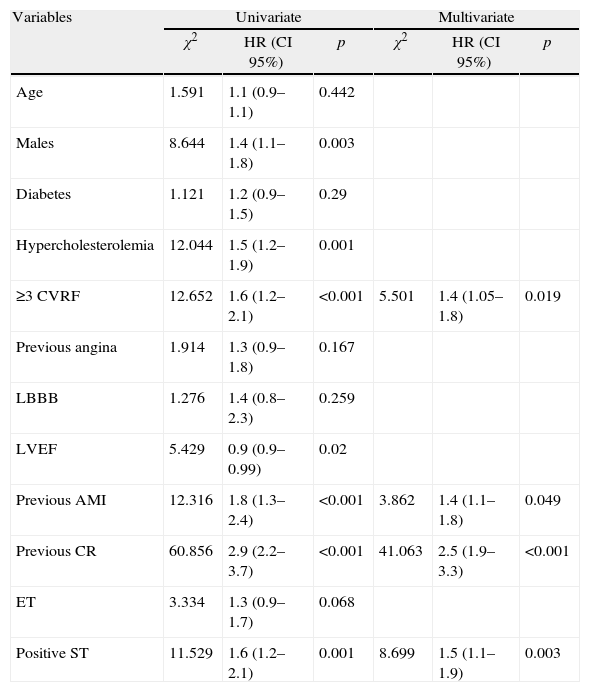The objective of this study was to investigate predictor variables at the moment of normal stress-rest myocardial perfusion gated SPECT for the indication of a second gated SPECT.
Materials and methodsA prospective, single center cohort study was conducted. We evaluated 2326 consecutive patients (age 63.6±13 years, 57.3% females) without perfusion defects and with normal left ventricular ejection fraction on a myocardial perfusion gated SPECT. Clinical and stress test variables were studied to predict indication of a second gated SPECT and presence of reversible perfusion defects in the second gated SPECT.
ResultsDuring a mean follow-up of 3.6±2 years a second gated SPECT was performed in 286 patients (12.3%). Independent predictor variables of a second gated SPECT were presence of three or more cardiovascular risk factors (χ2: 5.510; HR: 1.4; p=0.019), previous acute myocardial infarction (χ2: 3.867; HR: 1.4; p=0.049), previous coronary revascularization (χ2: 41.081; HR: 2.5; p<0.001), and a positive stress test (χ2: 8.713; HR: 1.5; p=0.003). Observation of perfusion defects in the 280 patients in whom a second stress-rest gated SPECT was performed was more likely in male patients (χ2: 4.322; HR: 1.9; p=0.038) who had a first pure pharmacological gated-SPECT (χ2: 7.182; HR: 2.6; p=0.007).
ConclusionsIn patients with a first normal myocardial perfusion gated SPECT, various clinical factors and variables derived from the stress test affect the indication of a second gated SPECT and the presence of ischemia in the latter.
El objetivo de este estudio fue investigar qué variables en el momento de la práctica de una gated-SPECT de perfusión miocárdica normal son predictoras de la indicación de una segunda gated-SPECT.
Material y métodosEstudio unicéntrico, prospectivo de cohorte. Se incluyeron consecutivamente 2.326 pacientes (edad 63,6±13 años, 57,3% mujeres) sin defectos de perfusión y con una fracción de eyección del ventrículo izquierdo normal en una gated-SPECT de perfusión miocárdica estrés-reposo. Se estudiaron variables clínicas y ergométricas predictoras de la indicación de una nueva gated-SPECT y de la presencia de defectos reversibles de perfusión en esta última.
ResultadosDurante un seguimiento medio de 3,6±2 años después de una gated-SPECT normal se practicó una segunda gated-SPECT en 286 pacientes (12,3%). Las variables predictoras independientes que influyeron en la indicación de una segunda gated-SPECT fueron la presencia de 3o más factores de riesgo cardiovascular (χ2: 5501; HR: 1,4; p=0,019), el antecedente de infarto agudo de miocardio (χ2: 3862; HR: 1,4; p=0,049), la revascularización coronaria previa (χ2: 41,063; HR: 2,5; p<0,001), y una prueba de estrés positiva (χ2: 8699; HR: 1,5; p=0,003). La observación de defectos de perfusión en los 280 pacientes en que se realizó una segunda gated-SPECT de estrés-reposo fue más probable en pacientes de sexo masculino (χ2: 4,322; HR: 1,9; p=0,038) que realizaron una primera gated-SPECT farmacológica pura (χ2: 7,182; HR: 2,6; p=0,007).
ConclusionesEn los pacientes con una gated-SPECT de perfusión miocárdica normal diversos factores clínicos y variables derivadas de la prueba de estrés influyen en la indicación de una segunda gated-SPECT y en la presencia de isquemia en esta última.
Article
If you experience access problems, you can contact the SEMNIM Technical Secretariat by email at secretaria.tecnica@semnim.es or by phone at +34 619 594 780.

Revista Española de Medicina Nuclear e Imagen Molecular (English Edition)












